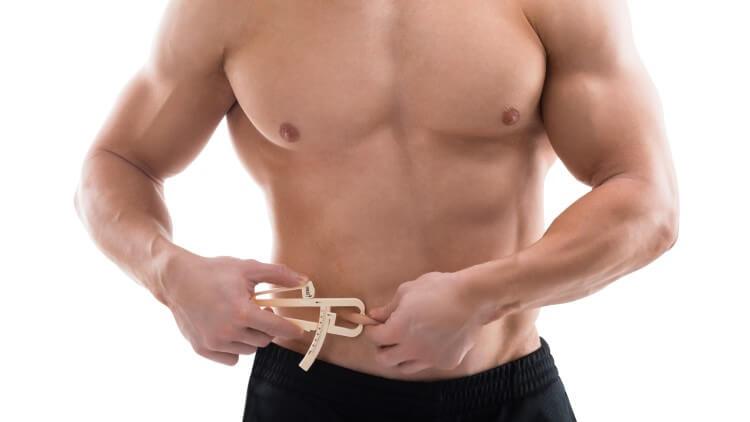
How to Get to 10% or 15% Body Fat - Tips For Men & Women
Have you set yourself a target of getting down to 15% body fat or lower? Reducing fat levels is beneficial for your health and gives the appearance of a leaner physique too. Many people strive to reduce body fat in order to make their muscles more visible and show off a hard-earned six-pack. But what’s the best way to go about it? And is there an optimal level that you should be aiming for? In this article, we share the ideal body fat percentages for different age groups along with practical steps for achieving them.
- What Is ‘Body Fat Percentage’?
- What’s an Ideal Body Fat % For Your Gender and Age?
- How Age Influences Your Body Fat Percentage
- This Is What Different Body Fat Percentages Look Like
- Effective Ways to Reduce Body Fat
-
How to Get to Less Than 15% Body Fat
- Nutrition
- Weight Training
- Cardio
- Additional Tips
What Is ‘Body Fat Percentage’?
Body fat percentage measures the ratio of fat compared with lean mass (like muscle and bone). It’s a good indicator of health since it provides insights into the body composition of a person instead of simply looking at their overall weight. It measures the amount of body fat as a percentage of overall mass. Body fat includes the subcutaneous fat that’s found underneath our skin as well as visceral fat which surrounds internal organs.
Many of us strive to reduce the amount of subcutaneous fat that’s stored on our body since this is the most visible. It’s this type of fat that makes us appear a bit ‘wobbly’ and contributes to people looking overweight. However, research shows that it’s actually the hidden visceral fat that is more damaging to our health. This type of fat is associated with metabolic disease, insulin resistance, and an increased risk of death.
What’s an Ideal Body Fat % For Your Gender and Age?
Men and women naturally have different levels of body fat. The amount of fat we process and store also increases as we age. So, what is an ideal amount for your gender and age range?
- Men aged 20-40 years old – the healthy range is considered between 8-19% body fat
- Men aged older than 40 years – the healthy range is considered between 11-25% body fat
- Women aged 20-40 years old – the healthy range is considered between 11-23% body fat
- Women aged older than 40 years – the healthy range is considered between 23-26% body fat
As you can see, a 15% body fat male would be considered healthy at any age. However, a 15% body fat female is only considered healthy if you’re under 40. For older women, it’s normal to have higher levels. This shows how our bodies can change as we age but still remain healthy.
How Age Influences Your Body Fat Percentage

Age influences body fat in a number of ways. Our levels gradually increase as we head into middle age, regardless of our gender. Research also shows that body fat then decreases again as people transition from their 60s into older age groups. This is partly due to biological changes but also because our lifestyle habits often change too. Having children, work commitments, or retiring from a career can all influence our physical activity levels and the food we eat. Here are a few of the factors at play as we age…
- Metabolism slows down
- Visceral body fat collects around organs
- Physical activity levels decrease
- Muscle wastage occurs due to age-related sarcopenia
- Energy levels decrease
- People may have less free time to look after their health
Although some of these changes are biological, others are within our control. This means that we can take steps to minimize the amount of body fat that’s gained as we age.
This Is What Different Body Fat Percentages Look Like
Women naturally have more body fat than men due to their hormonal balance and physical make-up. As a rule of thumb, women will have around 10% more body fat than men but that doesn’t mean they’re at a disadvantage. As you’ll see below, a six-pack tends to appear around the 19% level for women and 9% level for men.
https://www.instagram.com/p/BuzYkqvgzbb/
https://www.instagram.com/p/Bsp2kT5lrFO/
25-30% Body Fat
For men and women, having 30% body fat is generally considered unhealthy. It increases your risk of chronic diseases and is classified as ‘obese’ for men. Unfortunately, a male body with 25-30% fat will look overweight and there will be no sign of abs or muscular definition. Women with this amount of fat may have a rounded belly or ‘muffin top’. Having 25% doesn’t carry the same health risks as 30% but it’s still considered excessive in men.
20% Body Fat
In both genders, having 20% body fat is considered healthy. For men, they may look a little soft around the edges as there isn’t a great fat ratio compared with muscle. For women, they’ll usually have a fit overall appearance and look well-toned.
15% Body Fat
This is the point where men start to look lean. With 15% body fat, it’s easier to see muscular definition in the arms, legs, and chest. But for women, this is now the unhealthy range where periods can stop and your risk of osteoporosis increases.
10% Body Fat
So, what does 10% body fat look like? This is where those magical abs appear for men and is still considered healthy. But women should not be anywhere near this level as it’s detrimental to their health. Shrinking organs, damage to the nervous system, and dehydration can all occur if body fat becomes too low.
Effective Ways to Reduce Body Fat
If you’re looking for ways to reduce your body fat, then start with some simple changes to your diet and exercise regime. Here are a few of the most effective options…
- Manage your calorie and macronutrient intake to ensure you don’t have a surplus
- Do low to medium-intensity cardio sessions for 30+ minutes
- Increase your lean muscle mass so that you burn more calories at rest
- Drink less soda and alcohol
- Incorporate high-intensity workouts into your regime
- Avoid fast food, processed products, and sugary sweets
- Include stress-relieving activities like yoga into your routine
- Take a metabolism boosting supplement or appetite suppressant
These steps can help you reduce your body fat down to around the 15% level. Beyond that, you’ll need to make stricter commitments and avoid any activities with the potential to derail your efforts.
How to Get to Less Than 15% Body Fat
If you want to get less than 15% body fat, then you’ll need to put in some serious work. Making the change from 30% down to 20% is relatively easy in comparison. But as your body fat decreases, you’ll need to work even harder to reduce every 1%. Here is what you’ll need to do to get down to this level…
Nutrition
There’s no denying the fact that nutrition is key if you really want to get lean. You can’t out-train a bad diet so you’ll need to cut out takeaways, junk food, sugary treats, and alcohol completely. For some people, this simply won’t be sustainable long-term but it’s what is required to really drop those last few percentage points. A 10% body fat diet has very little room for flexibility – you’ll need to be diligent about calorie and macronutrient intake. Primarily eating plenty of protein and nutritious vegetables is key but that doesn’t mean you’re limited to just chicken and broccoli. Here are some tasty foods you should look to incorporate…
- Turkey, chicken, and fish.
- Tofu and tempeh.
- Chickpeas, kidney beans, lentils, black beans, etc.
- Broccoli, cauliflower, spinach, kale, peas, tomatoes, and peppers.
- Blueberries, raspberries, apples, lemons, and limes.
- Water, coffee, and herbal teas (without sugar or milk).
Weight Training
Weight training is essential for achieving a lean body. This type of exercise burns calories and can help you achieve the deficit needed to shift fat. But developing muscle mass will also mean that your body burns more calories at rest so you get a dual benefit. Lifting weights, doing strength-based classes, or calisthenic exercises will all help you to increase muscle. Just be sure to eat enough protein to support the extra demands on your body, otherwise, you may end up losing muscle instead of gaining it.
Cardio
There are two approaches to cardio when it comes to burning fat. The first is the age-old ‘slow and steady’ method. This involves long duration cardio sessions at a low to medium intensity – think jogging for 30-40 minutes on a treadmill. Working out for more than 30 minutes tends to use up all of your carbohydrate stores and forces your body into fat burning mode.
The second approach is high intensity interval training (HIIT). This involves alternating periods of fast and demanding activity (such as sprints or burpees) with very short rest intervals. HIIT burns a lot of calories and boosts the metabolism too. It’s been proven to shift fat and is also time-efficient. If you’re aiming to become a 10% body fat male or 15% female, then HIIT may be your new best friend.
Additional Tips
Fat loss is influenced by more than just calories. Although diet and exercise account for the bulk of it, there are other factors at play. Changes in hormones, stress, or other emotions can all affect how our bodies crave food and store fat. Getting sufficient sleep (7-9 hours per night) is an important component of a healthy lifestyle. Minimizing stress or doing activities that help to manage it will also aid fat loss too. Taking an appetite suppressant or metabolism boosting supplement can also help you get the most out of diet and exercise efforts.
Getting To 15% Body Fat – Summary
Measuring fat percentage assesses the body composition of a person and is a good indicator of overall health. Men naturally have lower body fat than women – 8-19% is considered healthy for men under 40 and 11-23% is ideal for women in the same age range. People tend to store more fat as they age due to a combination of biological and lifestyle changes. Reducing body fat involves a balanced approach to diet and exercise. Achieving seriously lean levels will require even more commitment and diligent control over food and workouts.




